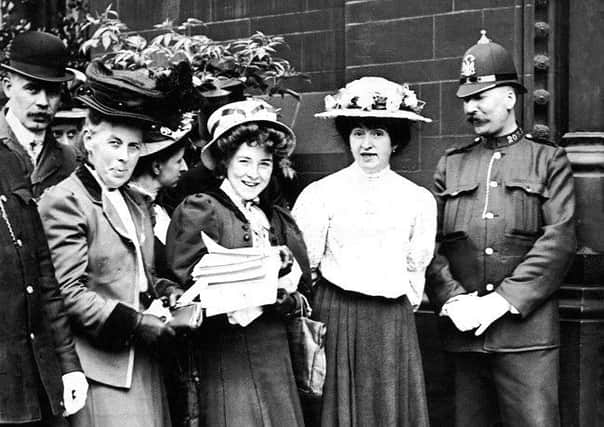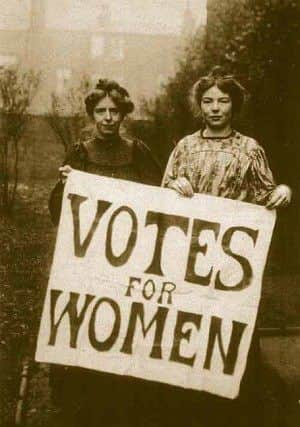Smashing windows, arson and pouring acid into postboxes


There was also an arson attempt at the University of St Andrews.
These militant tactics and the suffragette campaign in Scotland feature in a new book ‘The Scottish Suffragettes and the Press’ which is due to be published next spring by Professor Sarah Pedersen, director of research, at Robert Gordon University.
Advertisement
Hide AdAdvertisement
Hide AdProfessor Pedersen recently gave a talk on the subject of Female Suffrage in Fife 1900-1919 at Markinch Heritage Group.


She said: “Fife was very important during the suffragette campaign because East Fife was held by H. H. Asquith, who was firstly Chancellor of the Exchequer in the Liberal government that came into power after 1905 and then Prime Minister. Asquith was a convinced anti-suffragist and an important member of his party and therefore the suffragettes focused a lot of their attention on trying to get him to change his mind.
“In the autumn of 1906, several of the leading suffragettes came to East Fife and the surrounding area to campaign against Asquith as he attended the annual general meeting of the East Fife Liberal Association.
“These included Christabel Pankhurst, daughter of Emmeline Pankhurst, Annie Kenney and Teresa Billington. They travelled around the area to hold meetings in the days before Asquith arrived. On the day of the meeting, held at the Masonic Hall in Ladybank, the suffragettes hired two lorries and addressed the crowd from outside the hall.
Advertisement
Hide AdAdvertisement
Hide Ad“Mrs Pankhurst had joined them and she moved the final resolution in their meeting, that women should be given the vote.


“Needless to say, Asquith continued to refuse to support such a move – he felt that women did not need the vote because they were represented politically by the male members of their family and also because he thought involvement with politics would make women more ‘unwomanly’.”
Professor Pedersen continued: “As frustrations grew, the suffragette campaign became more militant, and by the years just before the start of the war, the suffragettes were using a number of militant tactics such as window-breaking, arson and pouring acid into postboxes to make their point. Acid was poured into the mailboxes in Dundee and in Fife the station at Leuchars was set on fire. There was also an arson attempt at the University of St Andrews.”
She said that after researching the Suffrage Movement in Fife she was only able to find one mention of Markinch. This was a suffragette meeting on Markinch train station where leaflets had been handed out.
Advertisement
Hide AdAdvertisement
Hide AdHowever, newspaper headlines from 1913 show the suffragettes were very active in other parts of the Kingdom. Some of the headlines read: ‘Women Suffragettes in East Fife’, ‘Suffragette Outrage at St Andrews,’ ‘Explosion Caused by Suffragettes’ and ‘No Vote for Women, Leven’.
A police conviction book, stored at Fife Archive Centre, reveals the crimes and punishment of Margaret Morrison alias Ethel Muirhead – the Suffragette who threw an egg at Sir Winston Churchill at a political meeting in Dundee in 1910. Teamed with her friend Fanny Parker, the pair caused chaos from Cupar to London. They smashed windows, threw bricks and assaulted prominent people to draw attention to their cause.
Incidences of sabotage, window smashing and arson grew in number and women serving sentences demanded to be treated as political prisoners. When this was refused many embarked on a hunger strike. To avoid force feeding the authorities adopted a “cat and mouse” policy whereby the offender was sent home. When she ate sufficient meals at home to regain good health she would be returned to jail and the process repeated.
The law breaking continued until 1914 when war was declared. At this time the suffragette movement ceased as the hostilities were of greater priority. Ironically it was the women’s contribution to the war effort which was the deciding factor in convincing men that women’s right to the vote was indisputable. In 1918 women over 30 were given the vote and 10 years later the age limit was reduced to 21.
Constitutional suffragists
Advertisement
Hide AdAdvertisement
Hide AdAs well as the militant suffragettes there were also the constitutional suffragists.
In 1897, various local women’s suffrage societies formed the National Union of Women’s Suffrage Societies (NUWSS), under the leadership of Millicent Fawcett. The NUWSS wanted the vote for middle class property-owning women.
They believed they would achieve their end using peaceful tactics – non-violent demonstrations, petitions and the lobbying of MPs. Fawcett believed if the organisation was seen to be intelligent, polite and law-abiding they would prove themselves responsible enough to participate fully in politics. Pic: Votes for Women lapel pin.